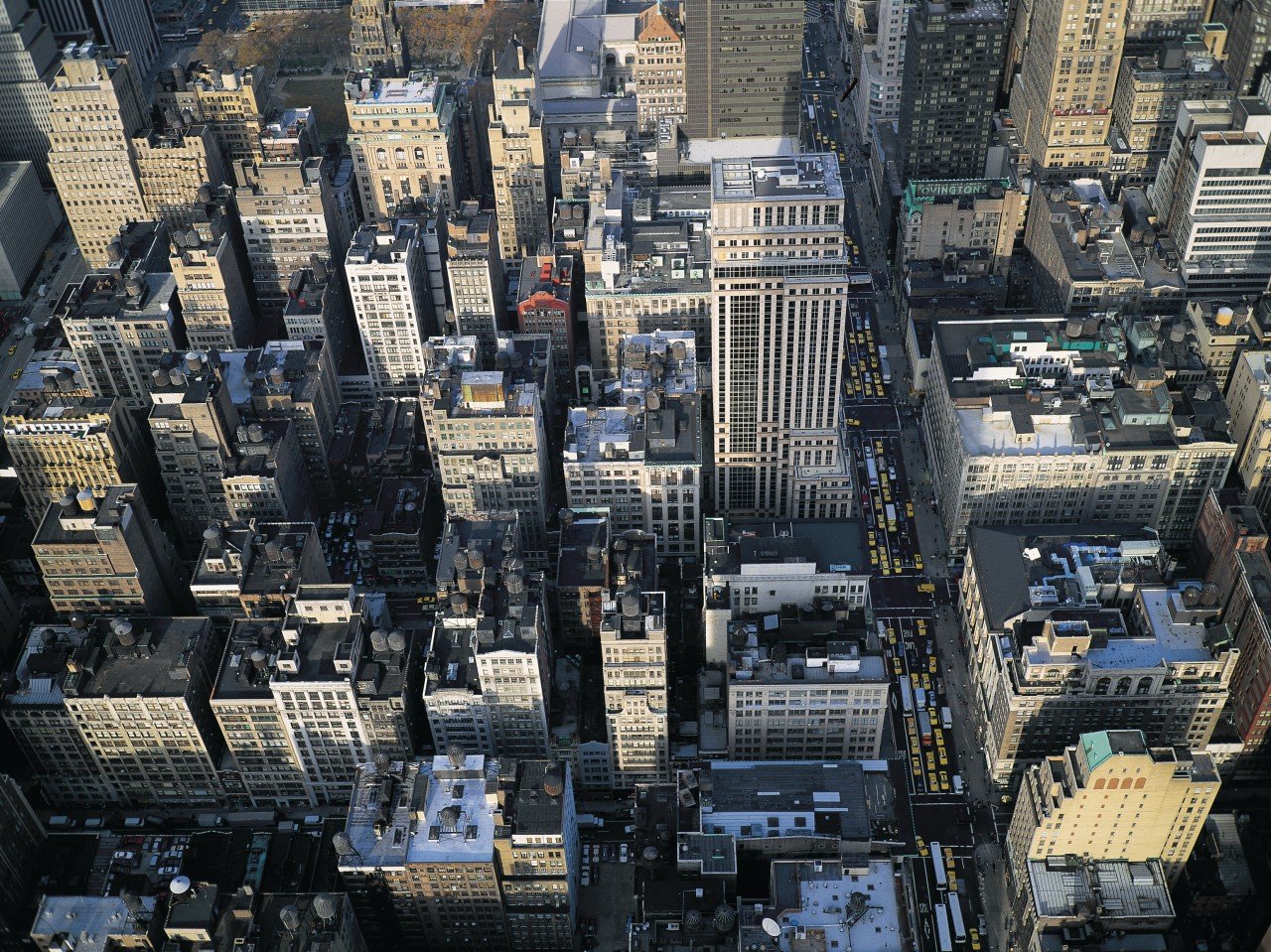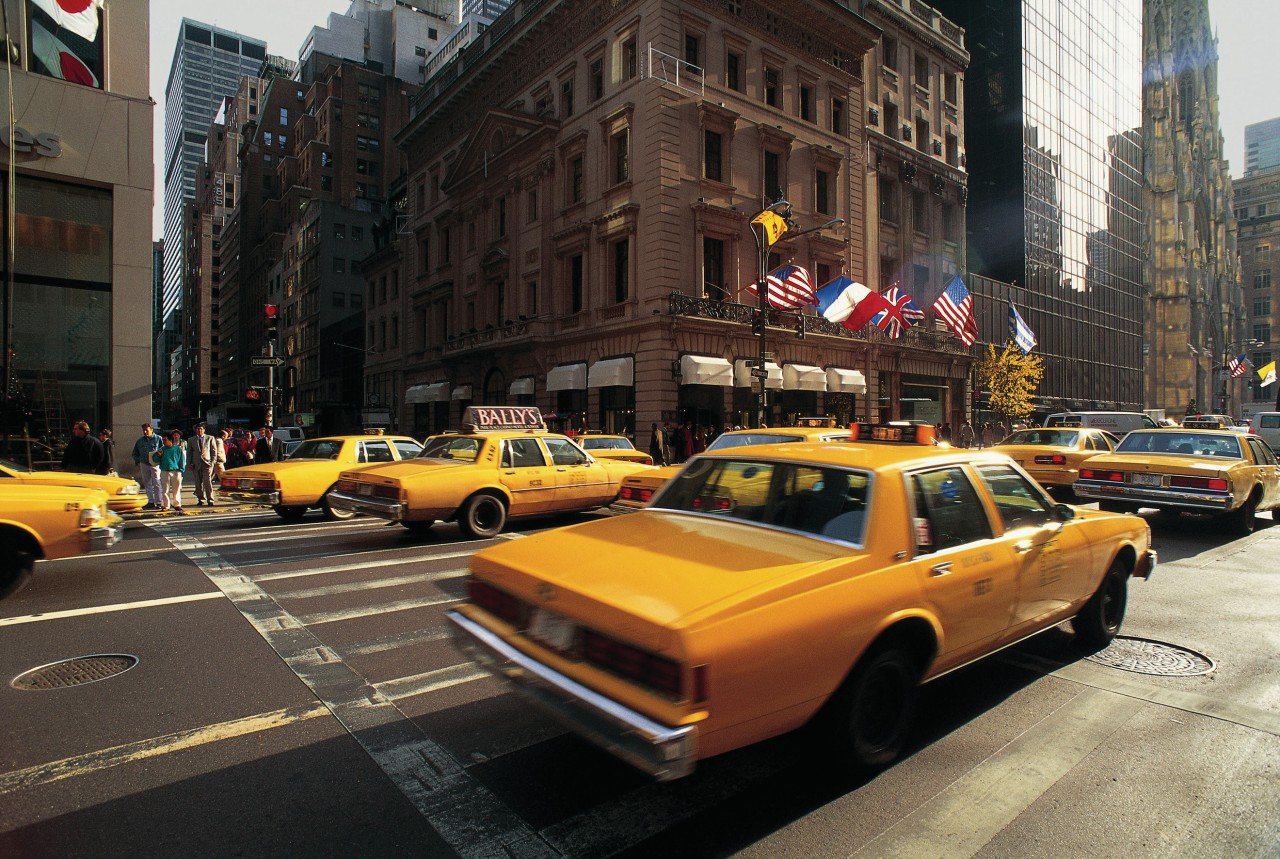Empire State Building, St. Patrick's Cathedral, Grand Central Terminal,... the must-see attractions that you will visit whatever your interest in old or modern architecture. Whether Art Deco enthusiasts, Georgian style, Fine Arts or Russian gothic art can be reassured, here is a visit to Manhattan from all its architectural angles!
Day 1: Times Square
Day 2: SoHo
Day 3: Lower Manhattan
 ©Tom Pepeira - Iconotec
©Tom Pepeira - Iconotec
The New Amsterdam Theater (214 West 42nd Street) is one of the oldest theaters of Broadway and the oldest example of Art Nouveau in New York. Note, its facade of Fine Arts style, partly hidden in 1937, during its transformation into cinema, by a pillar surmounted by a clock. Above the clock, you can see the sculptures representing the groups of angels. The beautiful Art Nouveau decorations were preserved inside. The Lunt-Fontanne Theater (205 West 46th street), completed in 1909, was designed by the architects Carrère and Hastings, designers of the New York main library on 5th Avenue. It has retained its Fine-Arts façade, which is still intact above the golden square which runs along the entire building. The Paramount Building (1501 Broadway), pyramidal type, was the highest in the area to its completion in 1927. It is surmounted by a monumental clock and a bright earth globe. It was for a long time the headquarters of Paramount, whose movie studios are now in Hollywood. Until 1964 a movie theater was there, a privileged place of the premieres of the film production giant. The Chatwal Hotel (128 West 44th Street), founded in 1905 by a group of professional actors and then called The Lambs club, was the first American theatre club. It served as a clubhouse and place of residence and work for theatre professionals. The building was designed by Stanford White, the architect of Washington Square arc, who finished his life under the bullets of a romantic rival. Brick building, in Georgian style, the first floor is decorated with columns and pilasters decorated with heads of rams, reference to sponsors. Rams heads are found carved on the next two levels. The building now houses a hotel, the Chatwal, and a restaurant that has taken over the original name of the site, The Lambs Club.I. Miller Building (1552 Broadway): You are right in Times Square, all the facades are hidden by the screens. But at 1552, if you turn at the corner of 46th street, you discover the south side of this small building. Four niches at the front house the statues of the most famous actresses of the 1920s, the second from the left is Mary Pickford, nicknamed "America's Sweetheart", the pioneer of Hollywood.
 ©Tom Pepeira - Iconotec
©Tom Pepeira - Iconotec
The Little Singer Building (561/563 Broadway), a magnificent building from 1903, is made of steel and red brick, with terracotta decorations. A large central bay, on nine levels and five wide windows, and ornate balconies give it all its elegance. You can admire the other facade of this L-shaped building at 88 Prince Street, between two buildings with fire escapes. Next to the Scholastic Building, the modern building of Aldo Rossi, which uses the same materials. It was completed after the accidental death of his Italian designer in 1997. The Roosevelt Building (478 Broadway) is a superb example of cast iron building, a type of cast iron constructions that are mainly admired in SoHo. This 1873 building, which announces Art Nouveau, is the work of Richard Morris Hunt, the architect of the base of the Statue of Liberty. By continuing Broadway to the south, you can see from 36 to 56 White Street a set of cast-iron buildings, those of Italian Renaissance style. Thomas Twinns (319 Broadway): further south, you can discover the main facade of this former cast-iron commercial building on Thomas Street, dating back to 1869. Its twin, on the other side of the street, was unfortunately destroyed in favour of a Mc Donald's... The large glazed surfaces are characteristic of this type of construction. By continuing Thomas Street on 50 meters (8 Thomas street), you can find a curiosity: the cast-iron ground floor is surmounted by three brick floors with granite colonnades... Russian Gothic type! By continuing to the Hudson, you can see the House of Relief (67 Hudson Street), an Italian Renaissance building. The escape ladders were after its construction in 1904. In Staple Street, you can see the passage between the buildings inspired by the Bridge of Sighs of Venice. At the end of Staple Street, you can see at 6 Harrison Street a beautiful red brick building with a tower, the Mercantile Exchange, the old New York stock exchange completed in 1884. Nearby, other beautiful examples of cast iron, such as the one-storey building on 172 Duane Street (1872) or 75 Murray Street (1858), one of the oldest facades in this material, where cast iron imitates stone.
 ©Tom Pepeira - Iconotec
©Tom Pepeira - Iconotec
Stop at One Wall Street - BNY Mellon Building. Built at the corner of Wall Street and Broadway and in front of Trinity Church, the skyscraper that now houses the Bank of New York was completed in 1931. It reaches 199 metres, with 50 floors and an unstalled limestone façade that is designed to impress by its height. Inside, the hall offers beautiful Art Deco mosaics. The Trump Building (40 Wall Street), Art Deco construction with its steel structure and limestone façade, was the country's highest skyscraper in 1931, with 72 floors and 281 metres high. It was doubled the same year by the Chrysler Building, whose architect secretly added an arrow of 38 metres, totaling 319 meters, new record... until the completion of the Empire State building the following year. The Wall & Hanover Building, "The Crest" (63 Wall Street, on the corner of Hanover Street), is a 35-storey building (123 metres) built in record time in 1929. It is inspired by Art Deco, but its decoration elements are eclectic: in the lower part, the large medallions represent ancient Greek coins, its summit is Gothic style, with gargoyles. The Twenty Exchange Place (20 Exchange Place), not far from Wall Street, originally The City Bank Farmers Trust Building, Art deco style, was completed in 1931. It is difficult to see the summit at 226 metres in this narrow street. Fourteen busts of hooded figures decorate its facade; they would represent the finance giants, seven smiling and seven wincing! Don't miss the lobby. The Delmonico's Building (56 Beaver Street), a little further south, is an exception. This small eight-storey brick building completed in 1891 is in Fine Arts style. It seems like the marble portal behind the facade columns comes from Pompeii. Del Monico, a family of restaurateurs would have reported it and used it for a previous restaurant built in 1835. The Barclay Vesey Building (140 West Street) is located just opposite the World Trade Center and was damaged in 2001, before being rehabilitated. It occupies a whole block. Built from 1923 to 1927 in Art Deco style, 152 metres high, it is a beautiful yellow ochre bricks building adorned with limestone sculptures, with arcades on Vesey Street.




Each Travel Idea is customizable according to your wishes

